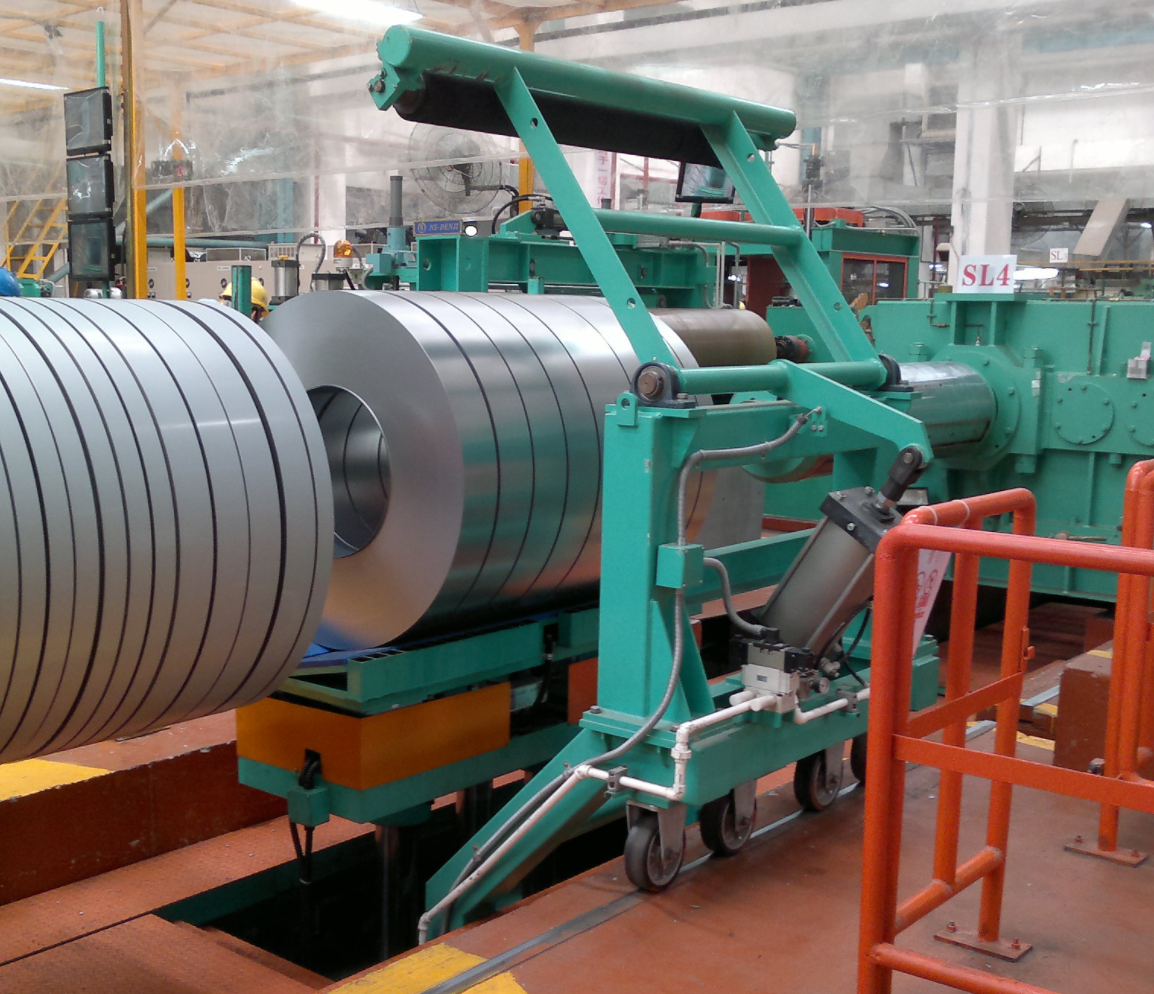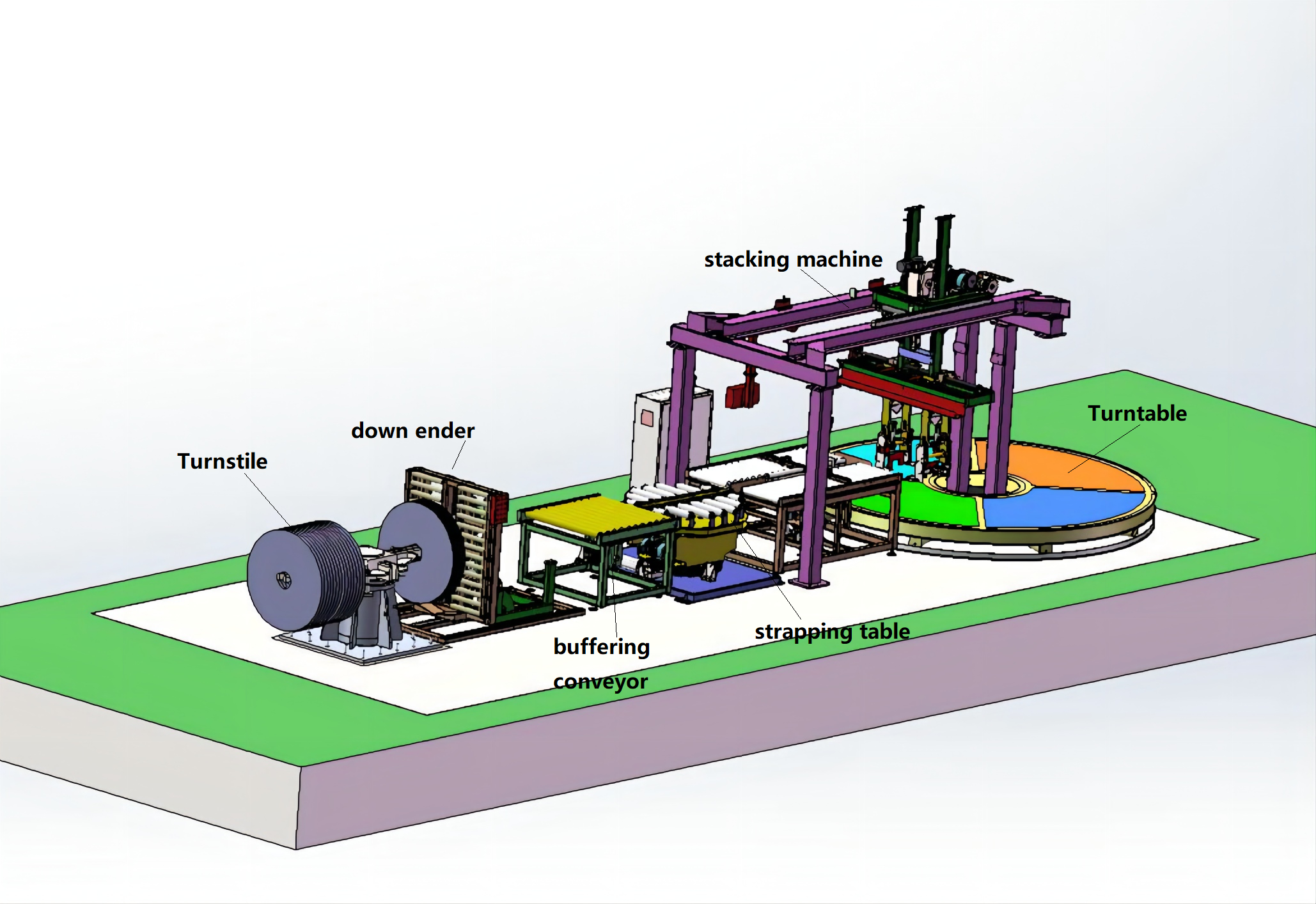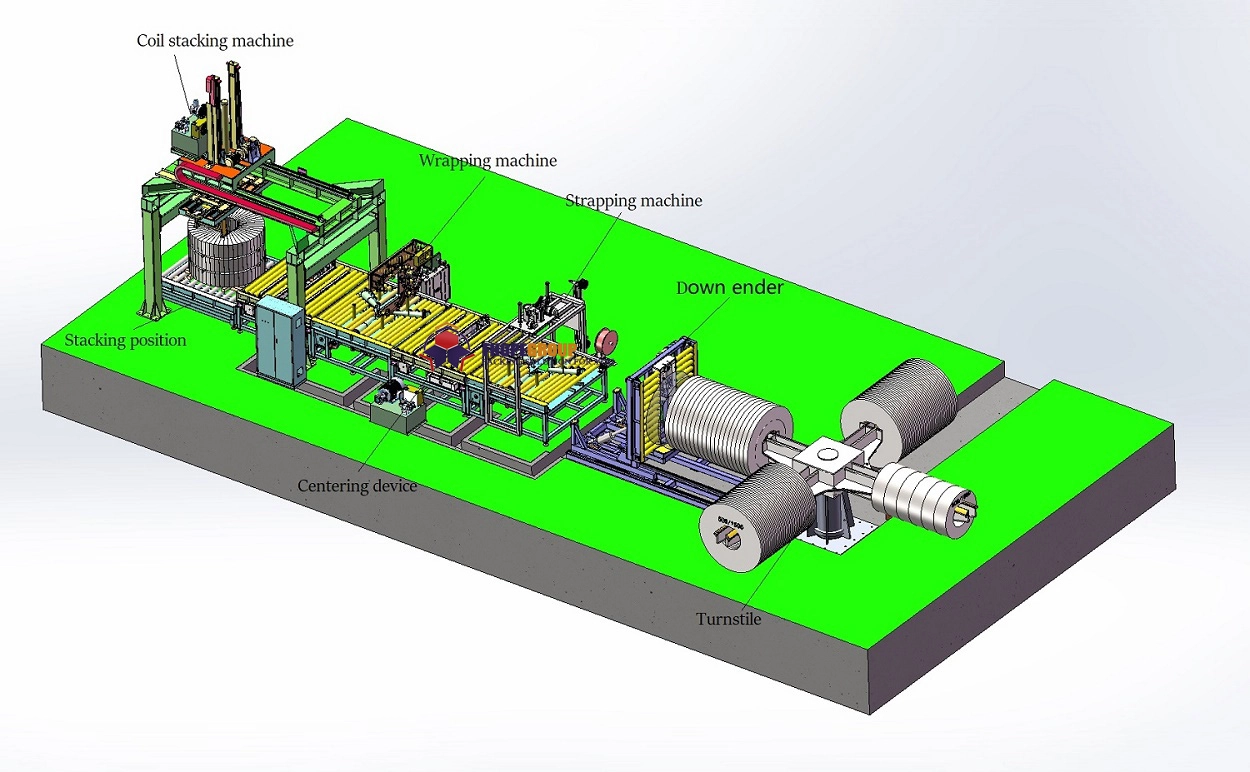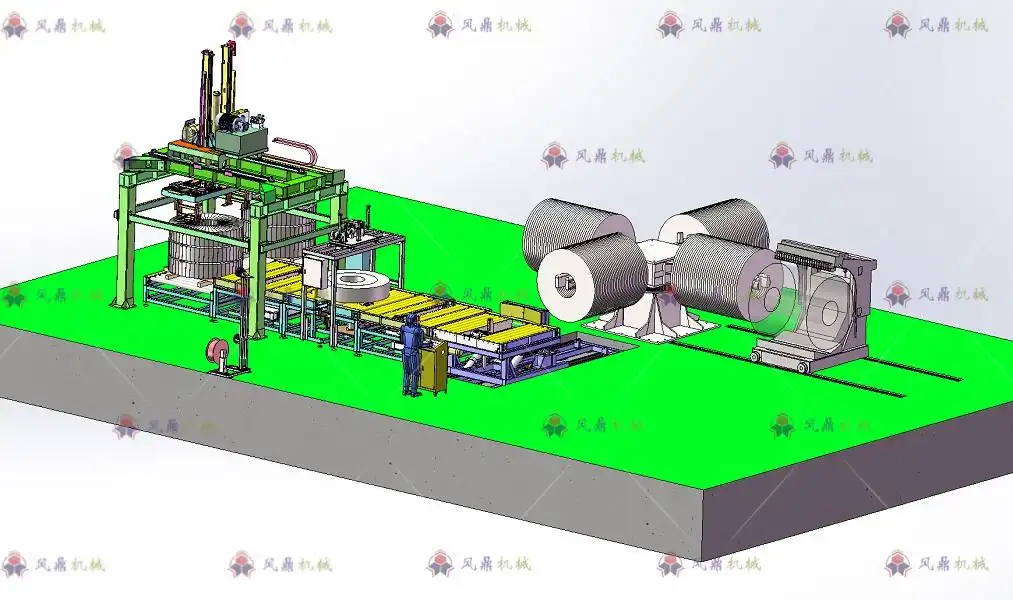Are you running a steel mill with packing lines that are getting old? Maybe they break down more often, use too much power, and struggle to keep up with production. Each minute of downtime costs you money. High energy bills eat into your profits. And an unsafe or inefficient packing area is a risk you can't afford. I know this feeling well from my years on the factory floor. You know you need an upgrade, but the investment feels huge and risky. A modern, automated steel coil packing line isn't just another cost. It's a powerful investment that pays for itself. It boosts efficiency, cuts energy use, and ensures safety, just like the high-standard systems we design for demanding markets like Canada.
A smart, safe, and efficient steel coil packing line for Canada integrates advanced automation, real-time data monitoring, and robust safety features. This combination significantly reduces manual labor, minimizes energy consumption per coil, and adheres to the highest international safety regulations. The result is stable, high-quality output you can count on.

You might be wondering how exactly a new line achieves these results. It’s not about just one machine; it’s about a total solution for wrapping machines. I've spent my career perfecting this, first as an engineer and now as a factory owner myself. I learned that true improvement comes from looking at the entire process. Let's break down the key areas where a modern packing line can transform your operations. We can start with one of your biggest headaches: energy costs.
How Can a New Packing Line Tackle Rising Energy Costs?
Do you wince every time you see your factory's electricity bill? I know that feeling. Fluctuating energy prices make budgeting a nightmare and directly hurt your bottom line. Your old packing machines are likely energy hogs. They run at full power even when they are idle between coils. This constant drain adds up quickly. It makes it much harder to compete and to reach your goal of reducing unit energy consumption. A modern packing line is different. It is designed with energy efficiency at its core. It uses smart technology to consume power only when needed. This simple change significantly cuts waste and lowers your operational costs.
A new packing line tackles energy costs by using high-efficiency motors, variable frequency drives (VFDs), and intelligent power management systems. These components ensure machinery only draws maximum power during active wrapping or transport. The line enters a low-power or sleep state when idle. This directly reduces the overall kilowatt-hours (kWh) consumed per ton of steel produced.

Deeper Dive: The Mechanics of Energy Savings
When I started my own factory, controlling costs was my top priority. Energy was a huge part of that. I saw firsthand how older equipment wasted money every single minute. That's why we focus so heavily on energy efficiency in our designs. It’s not just a feature; it's a core principle. Let's look at how this works in detail.
Smart Motor and Drive Technology
The heart of the savings comes from the motors and the drives that control them. Older lines often use motors that run at a single, constant speed. They are either on or off. A modern line uses high-efficiency motors paired with Variable Frequency Drives (VFDs). A VFD is like a dimmer switch for a motor. It allows the motor to run at the precise speed needed for the task. The wrapping machine can spin faster for larger coils and slower for smaller ones. The conveyor can speed up or slow down to match the production flow. This means the motor only uses the exact amount of energy required, instead of running at 100% power all the time. This alone can cut motor energy consumption by 20-50%.
Intelligent Power Management
A modern packing line is also smarter. It knows when it's not working. Instead of keeping all systems running between coils, a central PLC controller puts non-essential components into a low-power "sleep" mode. The conveyors stop. The wrapping ring motor idles. The hydraulic systems depressurize. When the next coil is detected, the system wakes up instantly. Think of it like a modern computer going to sleep. This eliminates the "vampire" energy drain that happens when machines are on but not productive.
| Feature | Old Packing Line | Modern Packing Line | Energy Impact |
|---|---|---|---|
| Motor Control | Single-speed, direct-on-line start | Variable Frequency Drives (VFDs) | Reduces motor energy use by 20-50% |
| Idle State | All systems remain fully powered | "Sleep mode" for non-active parts | Eliminates energy waste between coils |
| Braking System | Mechanical or dynamic braking (heat) | Regenerative braking (recovers energy) | Recaptures up to 15% of energy |
| Pneumatics | Prone to leaks, constant compressor use | Optimized with smart valves, leak detection | Lowers compressed air energy demand |
These features work together to achieve your goal of a 10% reduction in unit product energy consumption. It's a tangible, measurable saving that directly improves your profit margin.
What Makes a Packing Line "Smart," and How Does It Boost Productivity?
Is your current packing line a "black box"? You only know there's a problem when the line stops, causing a traffic jam that backs up your entire production chain. This lack of visibility makes it impossible to plan maintenance proactively. You are always reacting to problems instead of preventing them. Unplanned downtime from aging equipment kills your productivity targets. It makes achieving your goal of 95% equipment effective running time feel impossible. A "smart" packing line changes this completely. It gives you total visibility. It uses sensors and data to tell you exactly how it's performing, when it needs attention, and where you can make improvements. It turns your packing area from an unpredictable bottleneck into a reliable, highly productive asset.
A "smart" packing line is defined by its integration of IoT sensors, a central PLC control system, and connectivity to your Manufacturing Execution System (MES). It boosts productivity by enabling predictive maintenance, automating quality checks, and providing real-time data for optimizing workflow. This is how you can increase uptime to over 95%.

Deeper Dive: From a Dumb Machine to a Smart Asset
I remember working as a young engineer, spending hours troubleshooting a line that had stopped for no obvious reason. The problem was usually a small, worn-out part that we could have replaced easily if we had known it was failing. That experience taught me the value of data. A "smart" line is not about fancy gadgets; it's about giving you the data you need to be in control. It's the key to unlocking the full potential of your mill.
The Role of IoT and Sensors
A smart line is covered in sensors. These are its eyes and ears. Vibration sensors on motors and gearboxes can detect wear and tear long before a part fails. Temperature sensors monitor for overheating. Optical sensors count coils and check their position. All this data flows to a central Programmable Logic Controller (PLC). This PLC is the brain of the operation. It not only controls the machine's movements but also logs all the sensor data. This information can be displayed on a local HMI (Human-Machine Interface) screen for your operators. More importantly, it can be sent to your central factory control system.
From Reactive to Predictive Maintenance
This data transforms your maintenance strategy.
- Reactive Maintenance (The Old Way): The line stops. You find the broken part. You fix it. Production is lost.
- Preventive Maintenance (Better): You replace parts on a fixed schedule, whether they need it or not. This is costly and can still lead to unexpected failures.
- Predictive Maintenance (The Smart Way): The vibration sensor on the main bearing sends an alert. The data shows its performance is slowly degrading. The system predicts it will fail in approximately 40 operating hours. You can now schedule the replacement during a planned shutdown. There is no unplanned downtime. This is how you reach and exceed 95% uptime.
| Metric | Old Line (Reactive) | Smart Line (Predictive) | Impact on Productivity |
|---|---|---|---|
| Uptime | ~80-85% | >95% | More coils packed per shift |
| Maintenance | Unplanned, emergency repairs | Scheduled, data-driven | Reduced maintenance costs, less stress |
| Data Visibility | None. Manual logs. | Real-time, integrated with MES | Enables smart scheduling and optimization |
| Quality Control | Manual inspection | Automated checks for wrap tightness | Fewer rejects, higher customer satisfaction |
By connecting the packing line to your MES, you close the loop. The MES knows a coil is coming, so it tells the packing line what wrapping recipe to use. The packing line tells the MES when the coil is finished. This creates a smooth, automated flow and gives you a true, real-time picture of your entire factory's performance. This is the foundation of digital transformation.
How Do You Ensure a Packing Line Meets Strict Safety and Environmental Standards?
As a steel mill owner, are you concerned about meeting increasingly strict government regulations for worker safety and environmental impact? I know I am. An accident or a fine can damage your reputation and your finances. It's a weight on your shoulders. Older equipment often lacks modern safety features. It was built in a different time with different standards. It can also be inefficient, leading to more wasted wrapping material and higher energy consumption, which is bad for the environment. We design our packing lines to meet the highest global standards, like those required in Canada or Europe. This means we build in comprehensive safety systems from the very beginning. We also focus on using resources efficiently. This ensures you are not just compliant, but a leader in corporate responsibility.
To meet strict standards, a modern packing line incorporates physical guarding, light curtains, emergency stop circuits, and clear lock-out/tag-out (LOTO) procedures. Environmentally, it minimizes waste by using systems that precisely cut wrapping materials. It also employs the energy-efficient components we discussed earlier. This holistic approach ensures compliance with both safety regulations (like ISO 13849) and environmental standards.

Deeper Dive: Building a Responsible Operation
Safety is not negotiable. When I was starting out, I saw an accident caused by a lack of proper machine guarding. It's an image I will never forget. It taught me that production speed means nothing if your people aren't safe. Similarly, we all share this planet. Being a successful business in the 21st century means being a responsible one. That's why we build these principles into the steel of our machines.
A Fortress of Safety: Physical and Digital Guards
Modern safety is a multi-layered system. It's not just a fence.
- Physical Guarding: The entire line is enclosed with robust safety fencing and access gates. These gates have interlock switches. If a gate is opened while the machine is running, the system immediately stops in a safe state.
- Light Curtains: In areas where operators need to interact with the line, like the loading or unloading zones, we use light curtains. These are beams of infrared light. If a person or object breaks the beam, the machine stops instantly. This provides protection without a physical barrier.
- Emergency Stops (E-Stops): Bright red E-Stop buttons are placed at multiple, easily accessible points around the line. Pushing any one of them will halt all machine movement.
- Safe-Torque-Off (STO): This is a critical safety function within the motor drives. In an emergency, it cuts power directly to the motor, ensuring there is no unexpected movement during maintenance.
| Safety Feature | Description | Purpose |
|---|---|---|
| Safety Fencing with Interlocks | Physical barriers with sensors on the gates. | Prevents access to moving parts during operation. |
| Light Curtains | Infrared beams that detect intrusion. | Protects operators in open interaction zones. |
| Emergency Stop Circuits | Strategically placed buttons for immediate shutdown. | Allows anyone to stop the machine in an emergency. |
| Lock-Out/Tag-Out (LOTO) | Procedures and devices to isolate energy sources. | Ensures machine cannot be started during maintenance. |
Minimizing Environmental Footprint
Environmental responsibility is directly linked to efficiency. A machine that wastes less, pollutes less. For a packing line, this focuses on two areas. First, energy consumption, which we've already covered. Second, material waste. Our wrapping machines use sensors to measure the coil's dimensions. The system then calculates the exact amount of VCI paper, stretch film, or other material needed. It cuts the material precisely, eliminating the waste that comes from manual guesswork. This not only helps the environment but also saves you significant money on consumables over the life of the machine.
How Do You Justify the Investment in a Modern Packing Line?
As a business owner, you scrutinize every major capital expenditure. I do the same. You have to answer to your budget and ensure every dollar invested works hard for the company. So, how can you be sure that a new packing line will deliver a strong return on investment? The upfront cost can seem daunting. It's easy to fall into the "if it ain't broke, don't fix it" mindset. But that mindset can be dangerous. It ignores the slow bleed of money from constant repairs, high energy bills, and lost production from downtime. The justification for a new line is in the numbers. I've helped many clients, just like you, build a clear business case that goes far beyond the initial purchase price. We analyze the real-world savings in labor, energy, materials, and maintenance to show a clear and often surprisingly fast path to a lower total cost of ownership and higher profitability.
You justify the investment by calculating the Total Cost of Ownership (TCO), not just the initial purchase price. A modern line delivers a strong ROI through quantifiable savings. These savings come from reduced labor needs, lower energy consumption, minimized material waste, lower maintenance costs, and increased throughput. Together, these factors can easily lower your overall operating costs by more than 8%, directly impacting your bottom line.

Deeper Dive: The Business Case for a New Line
When I decided to establish my own factory, the single biggest challenge was managing capital. Every machine had to pay for itself. This forced me to become an expert at calculating ROI. A new packing line is a perfect example. Let's not think of it as a cost, but as a profit center. Here is how we break it down.
Calculating the Return on Investment (ROI)
The calculation is simpler than you might think. We look at the total investment (the cost of the machine, installation, and training). Then, we identify all the annual savings the new line will generate.
ROI (%) = (Annual Savings / Total Investment) x 100
A typical payback period for a modern packing line can be as short as 2-3 years, depending on your production volume and local costs. Let's look at where those savings come from.
| Savings Category | Old Line Cost Driver | New Line Savings | Estimated Annual Savings (Example) |
|---|---|---|---|
| Labor | 2-3 operators per shift | 1 operator to supervise | $100,000+ |
| Energy | Inefficient motors, constant running | VFDs, sleep modes | $15,000+ |
| Materials | Manual cutting, wrapping waste | Automated, precise material usage | $20,000+ |
| Maintenance | Frequent breakdowns, emergency repairs | Predictive maintenance, fewer parts | $10,000+ |
| Downtime | Lost production from failures | >95% uptime, more output | $50,000+ (in added production value) |
| Total Annual Savings | $195,000+ |
Note: These are illustrative figures. We would work with you to calculate the exact numbers for your specific operation.
The Hidden Costs of Inaction
What is the cost of doing nothing? This is a question many people forget to ask. Your old line isn't free. It costs you money every day. It costs you in wasted energy. It costs you in excess wrapping material. It costs you in maintenance technician overtime. It costs you in lost production when it breaks down during a critical order. These are the hidden costs that a simple ROI calculation makes visible. When you see that you are already "spending" a significant amount of money to keep an old, inefficient machine running, the decision to invest in a new, efficient one becomes much easier. It's not about spending new money; it's about redirecting the money you are already losing into a productive asset that will grow your business.
My Insights: Beyond a Supplier, Finding a Partner
I’ve shared a lot of technical details about motors, sensors, and ROI calculations. These things are important. They are the "how." But after more than two decades in this industry, I’ve learned that the "who" is even more important. Who are you working with? Are they just selling you a machine, or are they invested in your success?
When I left my job as an engineer to start my own factory, I was full of technical knowledge. But I quickly learned that running a business is about more than just building a good machine. It's about people. It's about trust. It's about finding partners who understand your vision and your challenges. I remember one of my first big clients. He was a lot like you, Javier. He had built his company from the ground up. He was tough, smart, and he questioned everything. He wasn't looking for the cheapest machine. He was looking for a solution that would make his factory better and more profitable for the next 20 years.
He didn't just want me to answer his questions. He wanted me to ask him questions. He wanted me to challenge his assumptions. We spent more time talking about his business goals—his frustrations with downtime, his worries about safety, his ambition to enter new markets—than we did talking about the price of the equipment.
That experience shaped the entire philosophy of SHJLPACK. I am not just a supplier. I see myself as your strategic partner. My goal is to give back the knowledge that this industry has given me. I achieved my own financial independence because of steel packing machines, and I've helped many clients grow their businesses substantially. Now, I want to help you do the same. This means providing full support through the entire process: helping you select the right equipment, being there for installation and commissioning, and most importantly, offering ongoing advice as you navigate your digital transformation and meet new environmental standards. You're not just buying a packing line; you're gaining a partner who has walked in your shoes and is dedicated to helping you succeed.
Conclusion
A modern packing line is a strategic asset. It cuts costs, boosts productivity, and ensures safety, securing your steel mill's future in a competitive global market.





